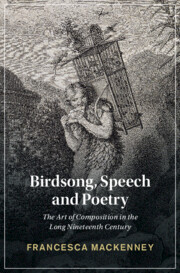Book contents
- Birdsong, Speech and Poetry
- Cambridge Studies In Nineteenth-Century Literature And Culture
- Birdsong, Speech and Poetry
- Copyright page
- Dedication
- Contents
- Figures
- Acknowledgements
- Introduction
- Chapter 1 The Science of Birdsong
- Chapter 2 The Science of Language:
- Chapter 3 ‘Prelusive Notes’
- Chapter 4 ‘Undersong’
- Chapter 5 ‘We Teach ’Em Airs That Way’
- Conclusion
- Notes
- Bibliography
- Index
- Cambridge Studies In Nineteenth-Century Literature And Culture
Chapter 5 - ‘We Teach ’Em Airs That Way’
Thomas Hardy
Published online by Cambridge University Press: 15 September 2022
- Birdsong, Speech and Poetry
- Cambridge Studies In Nineteenth-Century Literature And Culture
- Birdsong, Speech and Poetry
- Copyright page
- Dedication
- Contents
- Figures
- Acknowledgements
- Introduction
- Chapter 1 The Science of Birdsong
- Chapter 2 The Science of Language:
- Chapter 3 ‘Prelusive Notes’
- Chapter 4 ‘Undersong’
- Chapter 5 ‘We Teach ’Em Airs That Way’
- Conclusion
- Notes
- Bibliography
- Index
- Cambridge Studies In Nineteenth-Century Literature And Culture
Summary
This chapter places Thomas Hardy’s writings in the context of the heated arguments that arose between Charles Darwin and his most outspoken adversary, the philologist Max Müller, regarding the relationship between language and thought. While Müller insisted on a close, coeval relationship between the ability to frame ideas and the ability to express those ideas in words, Darwin throughout his writing demonstrates a lively fascination with the diverse and dynamic kinds of thinking that human beings and other animals appear able to perform ‘manifestly without the aid of language’ (Descent of Man, 1871). This chapter argues that Hardy’s writing is centrally concerned with the tragi-comic consequences of a world in which there is both language without thought and thought without language. It begins by exploring Hardy’s responses to these larger concerns in his novel Tess of the D’Urbervilles (1891-2) and concludes by examining his return to this theme in his poetry. The chapter discusses a wide range of Hardy’s poems, from canonical pieces such as ‘The Darkling Thrush’ (1900) to lesser-known works, including the series of short poems that Hardy is believed to have contributed to his second wife Florence Emily Dugdale’s volume for children, The Book of Baby Birds (1912).
Keywords
- Type
- Chapter
- Information
- Birdsong, Speech and PoetryThe Art of Composition in the Long Nineteenth Century, pp. 137 - 179Publisher: Cambridge University PressPrint publication year: 2022

